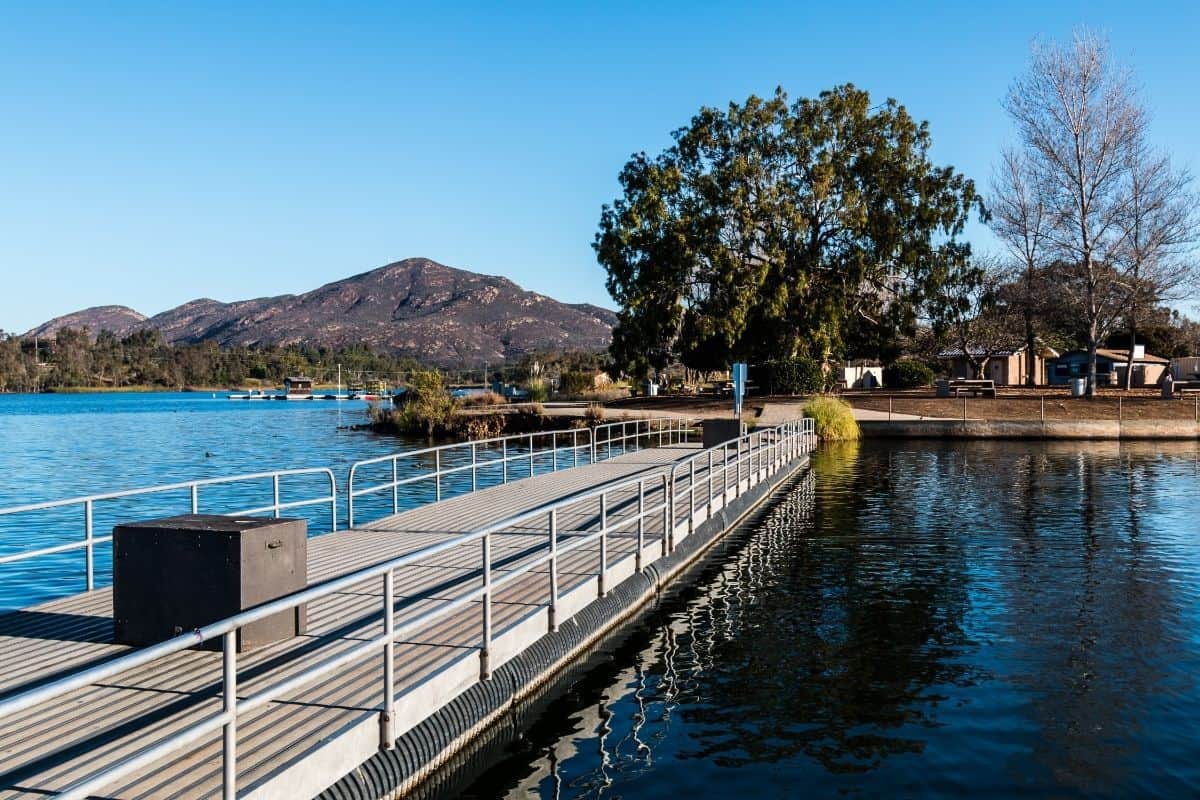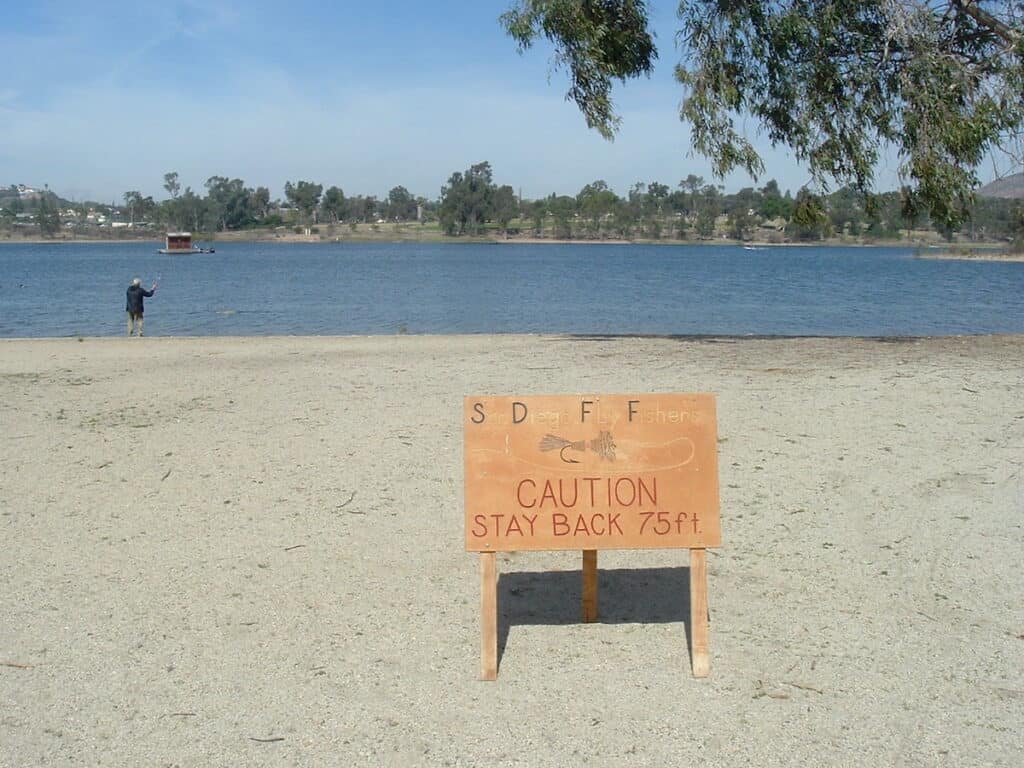Just a dozen miles east of downtown San Diego, Lake Murray is a haven for outdoor activities, including kayaking, hiking and bird watching.
And don’t forget fishing: Lake Murray is among the better lakes around San Diego for largemouth bass fishing and also offers catfish, crappie, bluegill, and even seasonal trout fishing.
Lake Murray (a.k.a. Murray Reservoir) is located in San Diego County within Mission Trails Regional Park, which is open for daytime use.
The 171-acre reservoir has over three miles of shoreline and excellent bank fishing access, and being in a boat will boost your odds of catching more fish. Rental boats are available or bring your private boat.
Bass Fishing
Simply put, for such a small lake, Lake Murray is known to produce monster bass.
The Florida-strain largemouth planted in the lake grow to enormous size in the moderate San Diego climate with plenty of baitfish (and smaller game fish) to eat.
The minimum length to keep bass is 12 inches. You can keep five bass, but many bass anglers release everything they catch, and especially the big bass.
Anglers will do best by finding limited underwater structures if they hope to catch a trophy-sized largemouth at Lake Murray.
The lack of docks, a mostly gravel bottom, and a maximum water depth of 95 feet means using electronics to locate fish is a big advantage.
Bass will congregate around the few rockpiles, artificial structures and grass available at Lake Murray.
Deep-diving crankbaits, jigs and various soft plastics will be your go-to lures during the summer months.
Bluegill, sunfish, shiners and crappie will be the most abundant forage fish during the summertime, so you will want to match your lure presentation as close as possible to these species.
Crawdads and nightcrawlers are available for purchase, or use a soft plastic to imitate either bait.
While fishing in the winter months, slow presentations will be the key to catching bass. Slowly dragging a jig along the bottom is a great tactic to get a bite.
Larger bass also tend to gobble up freshly stocked hatchery trout, so a swimbait or other lure that imitates a confused rainbow can be your ticket during stocking season.
Lake Murray’s ability to put out plenty of bass, including some real trophies, in such a small package has earned it a spot on our rundown of the Best Largemouth Bass Fishing Lakes in Southern California. What other lakes are there?
Catch More Bass
Bass Fishing: Simple How-To Techniques and Tips
Trout Fishing
Rainbow trout are stocked from fall into spring (approximately November to May) when the water temperatures are cool enough to support these cold-water fish.
Winter months are often the best bet for reliable water conditions for trout in Southern California.
If water temps allow it, trout tend to stay shallow, so anglers have the opportunity to fish for them from the shore.
The easiest and often most common approach to catching stocked trout is still-fishing with bait.
Popular baits include natural options like nightcrawlers and salmon eggs as well as prepared baits, including PowerBait and other doughs and formed baits.
If trout are near the surface, you can fish your bait under a bobber, which is especially fun for new anglers who like to “see” the bite through the action of the float.
At other times, trout will be holding deeper, and fishing your bait on the bottom or, especially floating a few feet up from the bottom will be the ticket to better catches.
Trout also can be caught quite effectively by casting and retrieving lures, including in-line spinners and spoons of various types.
Boaters often turn to trolling with lures or baits to cover more water and potentially catch more trout.
Trolling techniques vary, but regulars often will run their lure or baited hook behind a set of lake trolls or a dodger, which add a lot of flash to bring trout closer to investigate. That’s when they find your lure or bait.
Fly fishing is a more technical approach to trout fishing, but even rainbow trout are hardwired to feed on insects, so using artificial flies that imitate real bugs can not only be effective but thrilling.
Speak with the bait shop clerks or successful anglers if you’re having trouble getting a bite. They should be able to give you a few tips to get a bite or two!
There is no minimum length for trout, but you can only keep five.
Catch More Trout
Best Rainbow Trout Fishing Lakes in California
Trout Fishing: How-To Techniques and Tips
Catfish Fishing
As with the largemouth bass, catfish grow large in Lake Murray.
Channel catfish are most abundant, in part because they are planted here regularly, and a few blue catfish are also caught in the lake and can grow to massive sizes.
Catfish spend most of their time on the bottom, but depths can vary. During the bright, hot day, they often hunker down in deeper sections such as old creek channels.
Catfish will often get more active and possibly move into shallower water to feed in lower light conditions, including at night.
At Lake Murray, where night fishing isn’t allowed, prime-time catfishing is most likely to occur right when the lake opens at dawn or soon before it closes at dusk.
The best baits for catfish are cut baits (pieces of fresh fish or shrimp) and prepared stink baits, which are often in dough forms.
If possible, use cut bait of the same species of the most abundant baitfish in the lake, but oily fish such as mackerel also will do the job.
If you don’t have access to either of those bait types, use nightcrawlers but expect smaller panfish and other types of fish to compete for the bait.
Catfish are big and strong, and some devoted catfish anglers will use larger rods and reels to land them.
However, many anglers will employ a stout bass rod for their catfishing. We don’t recommend an ultralight panfish or trout setup unless you want to see your equipment get broken by big cat.
Lake Murray has no length limit for catfish, but you are only allowed to keep five.
Much more information: Best Catfish Fishing Lakes and Rivers in California and Catfish Fishing: Simple How-To Techniques and Tips.
More Fishing
Bluegill
Bluegill fishing is a great way to introduce kids to fishing and can be a blast for adults.
Bluegill can be caught using pieces of nightcrawlers and other small, natural baits along the grass edges and near the shoreline and docks, especially in the summer.
Crappie
Crappie are delicious fish to eat.
In the spring, crappie move shallow to spawn.
In the summer and winter months, they are deeper, and often around whatever structure they can find that’s not occupied by a giant bass.
Look for brush piles and other hiding spots in 10 or more feet of water to increase your odds of catching crappie.
Use light fishing gear. Small jigs and shiners are two of the best baits for crappie.
Hone your crappie-catching techniques with our how-to fishing article.
Also, discover the very best crappie fishing lakes in California.
The limit for both bluegill and crappie is 25 combined total.
Planning Your Trip
Lake Murray is a superb place to bring the family on a hike, picnic and fishing trip because it is near La Mesa, within 20-30 minutes from much of San Diego.
The lake is open sunrise to sunset nearly every day, with the exception of the second Tuesday of each month and a few major holidays.
There are picnic tables and grills along the lake for public use, or you can bring your grill. Ground fires are not permitted.
Dogs are allowed on a leash but must stay 50 feet from the water at all times. Swimming is not permitted in the lake. You must bring waders if you plan to enter the water, including using a float tube.
You’ll need a California state fishing license.
Bank and Boat Access
The gentle rocky slopes and lakeside trail system allow easy access to most of the lake from the shore.
Be aware that the hiking trail is not a full loop, so be prepared to turn around and walk back when you reach the end.
You also can rent a kayak, boat or bring your own (you need a boat permit).
There is a 5 mph no-wake speed limit on the entire lake and other boating regulations to follow.
More information
Check out the Mission Trails Regional Park website for fees, rules and updates.


